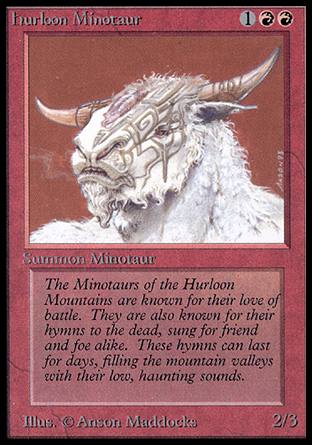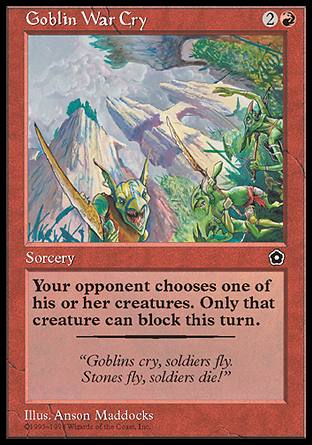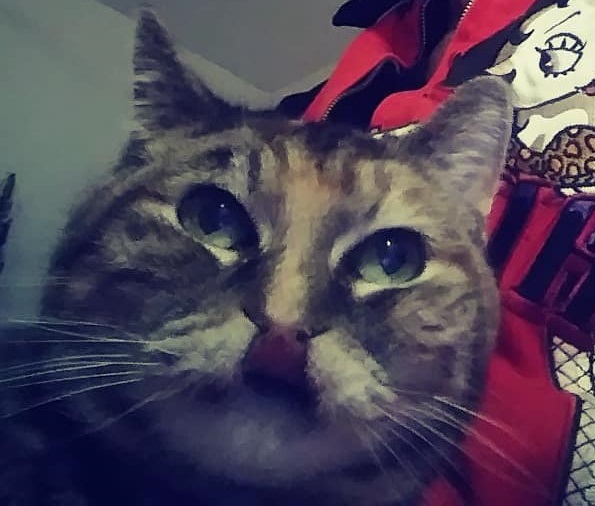Magic: The Gathering artist Anson Maddocks joins Magic Untapped for a Q&A.
In Magic: The Gathering's beginning, the game featured 25 artists. While some of these original Magic artists skipped out as soon as a few expansions in, many stayed on through the years to provide amazing artwork for amazing cards.
One such artist is Anson Maddocks.
 Active in creating works of art for the game from 1993’s debut set until 2006’s Time Spiral, Maddocks has created some of the most iconic images for MTG. This includes artwork for Hurloon Minotaur, the first "face" of Magic: The Gathering.
Active in creating works of art for the game from 1993’s debut set until 2006’s Time Spiral, Maddocks has created some of the most iconic images for MTG. This includes artwork for Hurloon Minotaur, the first "face" of Magic: The Gathering.
Maddocks took time out of his schedule to chat with Magic Untapped about his career making art for Magic, as well as a bit into what he’s up to some nearly 30 years since he first started making Magic art.
Magic Untapped: As one of Magic: The Gathering's original artists along with Christopher Rush, Mark Poole, Ron Spencer, and others, how did you first get involved with the game and were you expecting things to blow up the way they did with the game at the time?
Anson Maddocks: I was doing freelance illustrations for WotC’s primary product (at the time), Talislanta. Mostly black and white spot illustrations and an occasional cover. I was aware of the approach of Magic through WotC’s Art Director, Jesper Myrfors, as he kept getting more and more excited every time I would deliver more work for Talislanta. He would update me on the production schedule for Magic and make sure I was still willing to commit to creating images for it. With all of the initial budget issues, it became clear to most of the artists and many other contributors, that we would have to make the choice to live lean for a while to help the game make it’s first publication. I have always tried to keep my expectations for a project’s success within realistic boundaries, but with everyone at WotC becoming particularly energized and confident it was hard not to become infected myself.
MU: What inspirations and influences in your life drove you to becoming a professional artist?
AM: The reactions of other people (one particularly good public school art teacher, Dan Newman), the power that observation and the imagination have on creating interesting ideas, good art school instructors, coffee, [and] having an artist as a childhood friend to share the elements of developing our abilities. That last one might be the most important (tip of the hat to Mark Tedin). As far as turning it all into a way to make a living, as long as I was able to maintain connections with the public, opportunities seemed frequent enough to provide income. One example was when I looked through the Seattle Weekly and deciding whether I was good enough to do illustrations for that paper; I made a quick black and white portfolio with new images that I thought were competitive in quality with their current illustrations.
I made an appointment to meet with the art director where I showed him my work. I had just dropped out of the graphic design (illustration) department of Cornish College of the Arts, so I used one additional thing I had just learned and added something that might make the art director’s job easier: promising I could have a finished black and white illustration done with just an hours notice. Art directors generally have more stress to deal with so that proved to be a good move.
MU: How long do you typically spend on a piece?
AM: One to two hours unless it needs longer. Because of an error on my part, all four of the artworks for Urza’s Mine had to be completed in a single evening. The first versions I turned in, unfortunately, depicted exploding mines and had to be redone.
MU: From 1993's Limited (Alpha) through 2006's Time Spiral, you illustrated some 112 or so cards. What are some of your favorites and what were some of your "lessons learned" over the course of those 13 years?
 AM: If I liked any of my works, I could finally stop making them. They are all an effort to learn something. I actually kind of liked Goblin War Cry... (but of course, the artist credit was printed as "Michael Weaver." Don’t know whatever happened to those artist proofs.)
AM: If I liked any of my works, I could finally stop making them. They are all an effort to learn something. I actually kind of liked Goblin War Cry... (but of course, the artist credit was printed as "Michael Weaver." Don’t know whatever happened to those artist proofs.)
MU: How did artists during the early days of Magic decide on a fantasy style of art for the game? Were there discussions over making the art more realistic or more cartoonish?
AM: The art director chose the artists because of what he had seen of their work. He was able to get 25 artists on board to create the artwork necessary for the first printing and expected to see 25 different styles as a result. Between the artists, at least the few who happened to know one another, there was no discussion of a cohesive style to agree upon. The idea was more about a game with imagery that came from a variety of different styles, adding to the overall multicultural inspired flavor. It wasn’t until years later that those features would become obsolete, or seen as an element that spoiled the immersive potential of the game.
MU: Have you ever tried a more "out of the box" approach to a card where you try a new perspective or style?
AM: I only take a “boxed” approach to my work when I need to plant a seed of normalcy amongst my undulant glistening brood, so as to wave a friendly “hello, neighbor” to any of you who start to grow uneasy with me. Actually, Blood Lust is what happens to me when I try too hard to be different...I still think it’s funny though.
MU: Your art has always stood out among the rest of being different from that of a lot of Magic artists even today. To call out a few of your specific card arts, your illustrations for Maze of Ith appears to have a body trapped in some grotesque membrane sphere of sorts, there seems to be a fetus living inside of Living Wall, Blood Lust depicts a woman who seems to be a tad too interested in literal blood, and the cards Paralyze and Guardian Angel seems to be two parts of one larger piece of artwork. What are the stories behind them?
AM: Along with trying to create an image that would look good when reduced down to card-size, I was striving to achieve a reaction, whether that be repulsion, or a sense of intrigue. I put a lot of work into the concepts I came up with based on the card titles I was assigned and figured that Magic players who were buying the cards had expectations. And one of my many goals was to meet or exceed those expectations without simply giving them what they were used to seeing.
If I could create something unexpected, something the viewer might not be likely to come up with on their own; to me, that was one marker of success. As for the alleged relationship between the art for Guardian Angel and Paralyze, there actually was no intentional connection when I created them. The first time it was brought to my attention, was by a young player at GenCon who approached me with his father and asked me about it. I laughed and thanked him for showing me.
MU: What kinds of things are more tricky for you to create (landscapes, people creatures, etc.)?
AM: I am only really interested in the challenging subjects. The only way to learn to paint architecture successfully, for example, is by painting challenging architecture. I only really see improvement in my work when I take that advice myself.
MU: Magic players haven't had the opportunity to enjoy any new cards featuring your art since 2006's Time Spiral. Is it safe to assume you've moved on from creating artwork for the game or is there more yet to come?
AM: There are vast numbers of talented artists who would really like an opportunity to create artwork for a Magic card. With the full 10% of the Alpha Edition under my belt, in addition to the many others that followed, I think I may just be happy to have done what I have. I look forward to seeing what the work of emerging artists will do for the game’s future.
MU: Finally, what projects do you have going on now (Magic or otherwise) -- aside from taking good care of your cat, Judas, of course!
AM: We are going through a transition which will focus on efficiency of time usage and trying to avoid comfortable activities. (This roughly translates into: Brenda [Editor's note: Brenda is Anson's spouse] is making me catch up with my backlog of work!) Actually, Brenda is normally the M.C. I don’t even know what the rest of the planet is up to unless she brings it to the studio and reads it to me! Although I have recently completed some work for a new card game that has yet to be announced but is under production and expected to be released this year, which we are looking forward to! You can always subscribe to our newsletter on www.ansonmaddocks.com or check out our events page on the website to be kept in the loop with the latest news and projects. But I will tell Judas that you inquired about her. She is probably stalking creatures under the front porch at the moment....thanks for the questions!

Thank you to Anson for participating in this interview and his wife Brenda for facilitating it.









